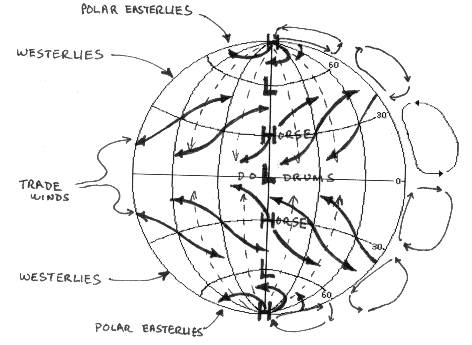1. They are equal in amount, but not equal in type. Incoming is mostly visible light, but outgoing is mostly infrared light.
2. The atmosphere is relatively transparent to short-wave radiation coming from the sun. Most of this energy is reflected back into space or passed on to be absorbed by the earth. The atmosphere is primarily heated by long-wave radiation re-radiated from the earth. The earth absorbs solar energy, mostly in the visible wave lengths, and radiates longer wave (mainly infrared) radiation back. The mechanisms for heat transfer are conduction, convection and the latent heat of evaporation. Water vapor, dust and carbon dioxide are especially adept at absorbing the long-wave radiation emitted by the earth and radiating it back to earth.
3. If the concentration of carbon dioxide in the atmosphere increased, more of the earth's re-radiated heat would be absorbed. It has been estimated that a doubling of atmospheric carbon dioxide would raise the global mean temperature by 1 .50C to 5.50C. Figure 7.6 would show an increased absorption of the long-wave radiation in the atmosphere as well as an increase in the amount of long-wave radiation re-emitted from the atmosphere. The amount of long-wave radiation passing directly though the atmosphere and into space without being absorbed would decrease.
4. The sun’s ray’s are more direct over the equator.
5. Heat is transferred from low latitudes to high latitudes primarily by a complicated system of ocean and air convection currents. Approximately one-third of the heat transfer is accomplished by ocean currents. The other two-thirds is transported by the winds in complicated, interconnected convection currents. Also carried by these winds is a huge burden of water vapor with its stored energy - the latent heat picked up during evaporation. When the vapor condenses, much of this latent heat of condensation is released into the atmosphere.
6. If the latent heat of evaporation magically dropped to 58 cal/g, the heat energy available to be released when the vapor condensed would be only one-tenth what it is now. If at the same time, water's heat capacity was raised to 10 cal/g Co, the ocean currents could carry up to ten times the heat energy they do now. Leaving aside such confusing considerations as the big jump in evaporation under these new conditions, the ocean currents would have the greater role in moving heat energy to high latitudes.
7.

8. As the seasons change, the earth heats and cools. Since the specific heat of water is higher than that for land, seasonal temperature changes will be less severe in the ocean than on the continents. So, relative to adjacent continental areas, the oceans will be cooler in the summer and warmer in the winter. The different water vs. land temperatures result in corresponding atmospheric pressure variations, distorting the regular, belt-like pressure systems (see diagram in #1) into more circular pressure zones. High pressure, such as found in the 30o belt, is accentuated over the ocean in summer (Hawaiian high). Low pressure, such as found in the 60o belt, is accentuated over the ocean in winter (Aleutian low) .
9. Winds blow counterclockwise around LOW pressure systems in the northern hemisphere, but clockwise around them in the southern hemisphere. For high pressure systems, wind directions are the opposite, with clockwise winds in the northern hemisphere and counterclockwise in the southern hemisphere.
10. The polar jet stream flows in the upper atmosphere between the Ferrel and Polar convection cells. Although this stream of rapidly moving air meanders significantly, the overall flow is west to east. If a meander in the jet stream flows toward the equator, speed is traded for angular momentum. The resultant slowing crowds air molecules together (like a traffic jam), piles them up, and forces those at the bottom of the pile downward, thereby inducing high pressure. Low pressure is induced below a pole-bound meander as air rushes upward to fill the space between air molecules moving apart from one another when angular momentum is traded for speed. The great bends in the jet stream act like colossal waves (Rosbey waves) migrating from west to east carrying the induced high and low pressure systems with them.
11. Tropical cyclones occur near the equator within warm air masses. They are not associated with fronts and they generally move from east to west with the trade winds. They have the fastest winds. Extratropical cyclones form at mid-latitudes between warm and cold air masses so they are associated with fronts. They track west to east with the Rosbey waves in the jet stream. Both types of cyclones are associated with low pressure systems.
8800 Grossmont College Drive
El Cajon, California 92020
619-644-7000
Accessibility
Social Media Accounts